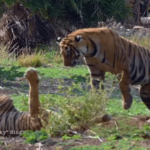Have you ever noticed your cat plopping down right in front of you, only to turn around and present you with their back? It’s a moment that can feel both confusing and oddly personal. Is your beloved feline snubbing you, or is there something deeper at play? The truth is both fascinating and a little surprising—what seems like indifference might actually be a secret sign of trust, affection, or even a quirky way of communicating. For cat lovers, understanding this mysterious behavior can open up a whole new world of connection with your furry friend.
A Silent Language: How Cats Communicate Without Words

Cats are masters of subtlety, and their body language speaks volumes. Unlike dogs, who might wag their tails or jump with excitement, cats use a far more nuanced approach to communication. When a cat sits with its back to you, it’s not a gesture of rudeness or disregard. Instead, it’s a form of nonverbal communication that speaks to their comfort and trust. In the world of felines, showing your back to someone means you feel safe—you don’t think you’ll be attacked or disturbed. For your cat, what may seem like a cold shoulder is actually a silent message: “I trust you enough to let my guard down.” This unique language is both touching and a little bit mysterious, reminding us how much our pets rely on actions rather than words.
Trust is at the Core: Feeling Safe in Your Presence

One of the most heartwarming reasons cats turn their backs is pure trust. In the wild, a cat would never expose its vulnerable side to a stranger or a threat. So, when your kitty chooses to lounge with its back to you, it’s a powerful sign that they see you as part of their safe space. Imagine your cat as a tiny lion—always on alert for danger. Now imagine they’ve decided you’re a friend, not a foe. This gesture is their way of saying, “I know you won’t hurt me.” It’s a subtle but profound compliment, showing you’ve earned a place in their inner circle.
Affection in Disguise: A Hidden Sign of Love

It’s easy to misinterpret a cat’s back as a sign of indifference, but many behaviorists believe it’s actually a form of feline affection. By sitting with their back to you, cats are inviting you into their world. They might not be the cuddliest creatures, but this gesture says, “I feel close to you.” Think of it as the cat version of holding hands or sitting side by side with a friend. Some cats will even glance over their shoulder to check in, confirming their affection. It’s a quiet way to bond, showing that love sometimes comes in the most unexpected forms.
Guardianship: Keeping an Eye on the World

Cats are natural-born protectors of their territory. When your cat sits facing away from you, they might be keeping watch over the room. In their mind, they’re acting as the sentry, guarding both you and the household from unseen threats. This protective instinct is deeply rooted in their DNA. By positioning themselves between you and the rest of the environment, cats can react quickly if anything unusual happens. It’s an instinctive way of caring for you—a sign they feel responsible for your safety, even if it’s just from the neighbor’s dog or a fluttering curtain.
Seeking Comfort and Warmth: The Practical Side

Sometimes, the explanation is far more practical: warmth and comfort. Cats love cozy spots and often choose to sit where they feel most at ease. If you’re sitting on the couch or your bed, your cat might turn their back to you simply because they’re settling in for a nap. Your presence brings comfort, and having their back toward you lets them relax fully. This behavior is similar to two friends sitting quietly together, enjoying each other’s company without the need for constant interaction. It’s a sign that your cat feels at home with you—comfortable enough to let their guard down and rest.
Establishing Boundaries: Independence in Action

Cats are famously independent creatures, and sometimes, turning their back is a gentle way of setting boundaries. They’re saying, “I’m here with you, but I also need my own space.” This doesn’t mean they don’t love you—it’s just their way of balancing closeness and independence. Think of it like a friend who enjoys your company but doesn’t need to chat constantly. By respecting this need for space, you build a stronger bond with your pet. Over time, you’ll learn to read these cues and appreciate their unique way of expressing themselves.
Inviting Interaction: Playful Signals and Subtle Invitations

Believe it or not, sitting with their back to you can sometimes be an invitation for interaction. Some cats do this as a playful tease, subtly encouraging you to reach out and pet them. They might flick their tail or glance back, waiting for you to make the first move. This gentle challenge keeps things interesting and gives your cat a sense of control over how and when they interact. It’s a dance of sorts—one where both you and your cat learn to read each other’s signals and respond in kind. These moments of playful interaction help deepen your relationship and create memories that last a lifetime.

Linnea is a born and bred Swede but spends as much time as possible in Cape Town, South Africa. This is mainly due to Cape Town’s extraordinary scenery, wildlife, and atmosphere (in other words, because Cape Town is heaven on earth.) That being said, Sweden’s majestic forests forever hold a special place in her heart. Linnea spends as much time as she can close to the ocean collecting sea shells or in the park admiring puppies.






